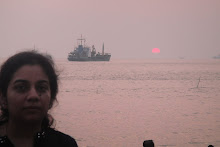
Title : Into The Wild
Author : Jon KraKauer
Publisher : Macmillan and Co
Sometimes after finishing a particular book, I find myself at loss of words to write its review. And for such books it takes a long time to compose the review. Somehow 'Into the Wild' belongs to that category. Its been almost two months since I finished reading this book and had jotted down the points that I wanted to include in the review but was not able to actually write it down. Christopher McCandless and his story never went out of my mind over the period of these two months and I guess the best way to vacate that portion of my mind is to write about him and his adventure.
By the very definition, humans are described as social creatures but does this inherent need to be social becomes too much of a burden for some people sometimes? This was the main thought which kept ringing in my mind while I was reading through this book. I read 'Into Thin Air' by the same author a while ago and some of the very fine co-bloggers and book reviewers highly recommended this book to me.
'Into the Wild' is a story of a young man, Chistopher McCandless who, unlike the people of his age renounced almost everything by giving away all the money that was reserved for his higher education to charity, abandoned his beloved car and other belongings, burnt his wallet money and severed the ties with his family. He reinvented himself as Alexander Supertramp and ventured into the wilderness of Alaska but unfortunately could not find his way out of it. His decomposed body was found in a deserted bus four months later. In 'Into The Wild', the author Jon KraKauer tries to retrace the path taken by Chris in an attempt to unravel the mystery and intrigue that wilderness creates in some and what are the temptations of this unknown world which some find hard to resist.
I must say that Jon has done a commendable job in trying to delve deep into the character of Chris, his inner urge to find himself and to be at peace with himself and what all contributed in making him the person he was. His research is impeccable as he goes on to interview almost all the people with whom Chris's paths crossed even though for a very short period. In one of the chapters, Jon goes into introspection and writes about his personal need for adventure and his trysts with nature through some of his own expeditions. He tries to draw parallel between his own self and that of Chris and comes to the conclusion that 'we had a similar intensity, a similar heedlessness, a similar agitation of soul' but none of them were suicidal. Some people may find this chapter out of place in the normal flow of the story but I found it quite relevant because being in almost the similar kind of frame of mind at some point in his life, author could relate to Chris so much better and perhaps it was just ill luck that Chris could not survive the ordeal(?) or his chosen path to self realization.
A very poignant and sensitive story of a young boy, especially the part where Chris's sister reminisces about their together time and the tearful adieu of the whole family as they see his last abode - the bus in the wilderness. It surely is one of the most haunting reads for me in recent past. This will leave the readers with a feeling of sadness and pity for the youth who found solace being closer to nature, was full of dreams but unfortunately did not get the time to give shape to his life during a very short stint in this world.
I really liked these passages from the book which sum up the author's best efforts to understand what went wrong in the case of McCandless.
"It would be easy to stereotype Christopher McCandless as another boy who felt too much, a loopy young man who read too many books and lacked even a modicum of common sense. But the stereotype isn't a good fit. McCandless wasn’t some reckless slacker, adrift and confused, racked by existential despair. To the contrary, His life hummed with meaning and purpose. But the meaning he wrested from existence lay beyond the comfortable path : McCandless distrusted the value of things that came easily. He demanded much of himself - more, in the end, than he could deliver."
"In the end, it looked like he was ready, perhaps to shed a little of the armor he wore around his heart, that upon returning to civilization, he intended to abandon the life of a solitary vagabond, stop running so hard from intimacy and become a member of the human community. But no body will ever come to know about what actually happened. His solitary thoughts ended with him."













.png)








